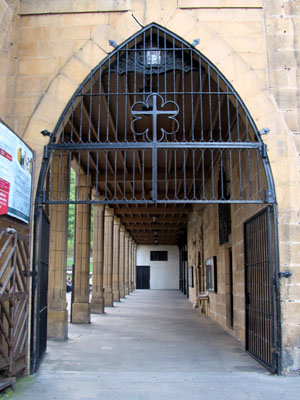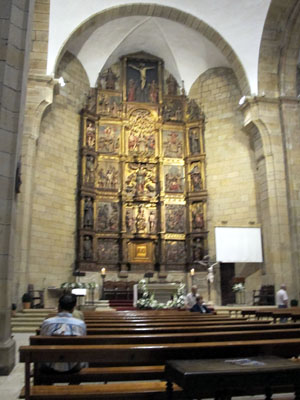One of my favorite websites is called Ship of Fools. It is a very funny site produced in England that comments on various aspects of Christendom. One of the recurring columns is called "The Mystery Worshipper". Various self-appointed folk travel to churches and participate in services and report the story following a pre-selected set of questions (see below in bold). Now most of these folk are squarely in the Anglo-Catholic tradition and like their "smells and bells" (high church pomp--heck many of them can tell you who wrote the setting for the Mass being played!), but they usually report with a fair amount of humor, tolerance, and Christian affection for traditions other than their own. Here Augustine the Aleut (mystery worshipers adopt pen names) is walking the northern route of the Camino (the route I'll be following) and reports in on a service he attends one September evening in Zarautz. Several things stand out to me--the "naturist" section of the beach I'll have to come through to get to Zarautz, how full the church is on a Friday night, the passing of the peace with dignity and warmth, and sharing a bottle of txakoli Basque wine after Mass. Nose around once you get to the full website, its full of fun.
http://shipoffools.com/index.html
| 2307: Santa María la Real, Zarautz, Gipuzkoa, Basque Country, Spain |
 |
| Mystery
Worshipper: Augustine the Aleut. The church: Santa María la Real, Zarautz, Gipuzkoa, Basque Country, Spain. Denomination: Roman Catholic, Diocese of San Sebastian. The building: There have been churches here for about a thousand years or so – maybe more. This one likely dates from the 15th century, but was built on the ruins of an iron age edifice, likely a fort. Its mullioned windows, arrow-loops and modillions give this building the appearance of an ancient fort. It has an outstanding baroque altarpiece by Andres and Juan de Araoz, featuring the image of Santa María la Real. There is a 9th century necropolis here, with lots of tombs from the 11th and 12th centuries. The church: Santa Maria la Real is the main church in the town of the coastal town of Zarautz. The neighbourhood: Santa María la Real sits on the far western side of Zarautz, about 100 metres or so from the shore and the western gate of the old city walls. About 200 metres to the east, there are a number of cafés and restaurants around the Plaza Zaharren. Ferdinand III of Castile gave the city its charter and rights in 1327 and it still feels pretty medieval. It's on the fifth stage of the coastal route of the Pilgrim's Way through through Gipuzkoa province in Northern Spain (the Basque country). The cast: There was no notice or announcement, and there is no parish website. The priest was in his fifties. The date & time: Friday, 30 September 2011, 7.00pm. What was the name of the service? Parish Mass. How full was the building? We could probably have squeezed in 300. There were over 200 present, of a wide range of ages, and likely as many men as women. Unlike many Spanish churches, there appeared to be a spread of social classes. Basque Catholicism has a populist, left-wing flavour, unlike the rest of Spain. Here the Church was one of the pillars of Basque language and consciousness and, in Francoist days, many clergy suffered imprisonment. Did anyone welcome you personally? A few people noticed that there was a stranger in the church, and nodded to me. Was your pew comfortable? It wasn't too bad, and the kneeler was well spaced from the pew ahead. I had no complaints. How would you describe the pre-service atmosphere? There were sounds of people greeting each other as they took their seats. What were the exact opening words of the service? "Aita, Semea, eta Espiritu Santuaren izenean." (In the name of the Father, the Son, and the Holy Spirit.) What books did the congregation use during the service? There were two screens at the front of the church, which fulfilled this need. What musical instruments were played? This was an evening service, and there were no instruments aside from the organ. Did anything distract you? Not particularly, other than the fact that the church was fairly full and I had to study the situation carefully before I found my favourite spot up on the epistle side.  Was the worship stiff-upper-lip, happy clappy, or what? Neither, but the singing was full-hearted and full-voiced – the rafters did actually ring. This was quite unlike any Latin-rite RC church in Canada. The peace was passed in a graceful manner, with a very well-dressed older woman shaking my hand, and a Vin Diesel-wannabe coming up and greeting me with both hands on my shoulders. Normally, I would have thought this a gross invasion of personal space, but here it seemed to be fine. Perhaps it was because I was still recovering from the 22km walk from San Sebastian. Exactly how long was the sermon? 12 minutes. On a scale of 1-10, how good was the preacher? N/A – I tried to follow him but he spoke in Basque (as I realised later on) and I couldn't understand a word of it. In a nutshell, what was the sermon about? I was very frustrated, furiously squinting my ears to catch some words. I know that my Castilian Spanish is rocky, but I can usually get the gist of things and can follow sermons moderately well. I wondered if there was a Biscay accent, which sounds impenetrable to wandering Canadians. It was only during the consecration, as the prayers were projected onto the screen, that I realised that the mass was in the Basque language, cognate to no other tongue known to man. No wonder I understood nothing! Which part of the service was like being in heaven? Aside from the wholeheartedness of the singing, a realisation that I could get an awful lot from the actions without being able to follow a single word of what was being said. And which part was like being in... er... the other place? Total incomprehension. I couldn't figure out a blessed word. What happened when you hung around after the service looking lost? Everyone poured out the doors onto the porch to chat furiously, or they headed off to cafés and restaurants. The clergy disappeared and I was unable to obtain a stamp for my pilgrim's credential. How would you describe the after-service coffee? They don't do that here, but I ran into a local (French-speaking) teacher, whom I had met earlier at the naturist end of the local beach, which one encounters descending from the hills to the east of the town. He invited me to share a post-mass bottle of txakoli, the local white wine, and his younger daughter gave me a very intense lesson in Basque plurals, as well as the etymology of local place names. Her older sibling rolled her eyes in disgust at this display of erudition, while the father beamed. The older sister's boyfriend glowered at me with inchoate fury, apparently viewing me as some sort of exotic rival, in spite of my aged and haggard appearance. How would you feel about making this church your regular (where 10 = ecstatic, 0 = terminal)? 8 – If I lived in Zarautz, there really isn't much choice, aside from the chapel of the Poor Clares. Even though I couldn't understand Basque, I would give it 8/10 as everyone was friendly. Did the service make you feel glad to be a Christian? The quiet friendliness of parishioners to this stranger among them. What one thing will you remember about all this in seven days' time? The lesson in Basque plurals; it still makes my head hurt. |
No comments:
Post a Comment